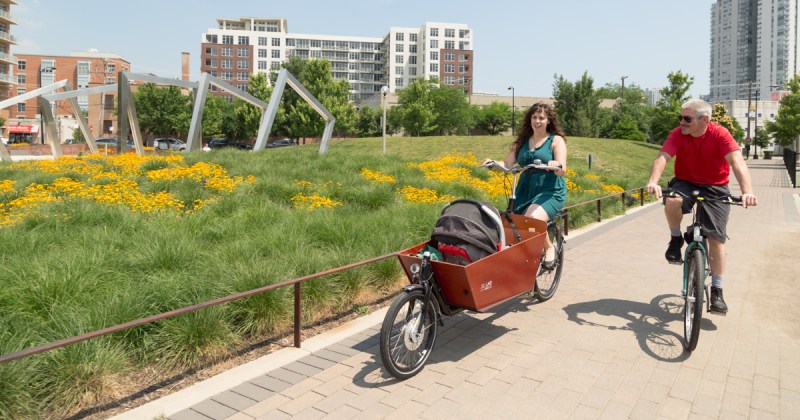There's a widespread belief in the biking world that one reason to build comfortable bike infrastructure is that if streets are safer, more women will bike.Women are, as one saying has it, an "indicator species" for good biking. Join protected bike lanes, off-street paths and side-street bike boulevards into a network and one mark of success will be that allegedly risk-averse women will start to ride in larger numbers.
Here's one key bit of evidence for this belief: if you ask, women are often more likely to say they prefer comfortable bike infrastructure, depending on the exact question. For example, here's a survey of people biking in recently constructed protected bike lanes in six cities. In every case, women were at least somewhat more likely to say they had increased their biking in general due to the presence of protected bike lanes:
Interestingly, though, when researchers asked more specific questions such as "do you bike on this street more often?" the gender differences vanished.
Studies don't confirm that women are actually much less risk-averse than men while biking
A different study co-authored by one of the same researchers (Jennifer Dill of Portland State University) used GPS devices to track the actual behavior of men and women -- and found much less variation between the genders. Working with her co-author John Gliebe, Dill measured the difference between the shortest possible path for a trip and the actual path, essentially calculating how far people were willing to go out of their way to use various types of bikeways. There were slight differences between the genders, but nothing dramatic or even particularly consistent.
Another argument you'll hear in favor of the "women are an indicator species" theory: Cities with more bicycling also tend to have more gender parity. Below are a handful of U.S. cities that have put significant effort into bike infrastructure. The number in parentheses is the percentage of commutes by city residents that happen by bike; the bars indicate the gender split among bike commuters.
There is definitely a trend here, but look more closely and you'll see flaws too. Why are D.C. and New Orleans so much more female-friendly to bike in than Seattle and Austin? Why is Davis barely more gender-balanced than Minneapolis despite having quadruple the rate of bike commuting? It seems possible that physical issues like topography might matter as much as psychological ones like risk.
The world's bike-friendliest countries, too, have more gender balance in biking: In the protected bike lanes of the Netherlands, the bike-friendliest country of all, women outnumber men. But some have observed that household-related trips in the Netherlands may be uncommonly gender-balanced, and that Dutch children are more independently mobile than American children.
Whether your city has protected bike lanes or not, it's a lot easier to bike to work when you don't need to pick up two kids and a gallon of milk on the way home.

Even if there is some gender difference in behavior, it's always swamped by this fact: streets and cities where many women bike are also streets and cities where many men bike.
The point of infrastructure isn't to make biking pleasant for women. It's to make biking pleasant.
Maybe men have been taught to be afraid to talk about their feelings
All of this is enough to make one wonder whether women are actually much more risk-averse in biking than men ... or if men are just less likely to publicly admit that they, too, prefer comfortable separated bike infrastructure.
That's the intriguing idea raised the other day by Katja Leyendecker, a UK-based civil engineer turned Ph.D. candidate who specializes in biking and other transportation behavior choices. From her post:
Women, through socialisation, are more attuned (allowed) to talk about emotional matters (without being called weak – patriarchy might give us an eye-roller, but you certainly would not be called a weakling per se, you are already labelled as the weaker sex anyways). Sad as it is, women are better placed to talk about fears and desires (spare a thought for the suffering man, who ought to repress these in our society which can lead to many a problem). In relation to what’s needed for infrastructure women can probably be more expressive and more honest in their needs for separation and protection from motor vehicles aka cycleways, protected bike lanes. Whereas man may feel they cannot say this, or they are ok to cycle in those conditions and actually are happy with cycling in motor traffic.
We've written before about how biking was defined for decades in the United States around values of self-important masculinity and athletic competition, with tragic consequences for the country's bikeway designs. How much more tragic it'd be if, for all these years, huge numbers of the men shaping those street designs were simply afraid of publicly confessing that biking amid auto traffic wasn't actually what they wanted in their daily life, either.
PlacesForBikes is a PeopleForBikes program to help U.S. communities build better biking, faster. You can follow them on Twitter or Facebook or sign up for their weekly news digest about building all-ages biking networks.






